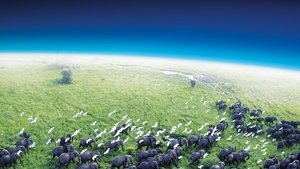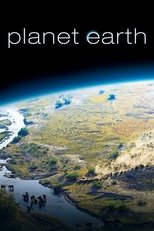General Information
Glossary: P
First Air Date: March 5th, 2006
Last Air Date: December 10th, 2006
Created By: ---
Star Casts: David Attenborough
Aired On: BBC One
Episode Runtime: minutes
Total Seasons: 1 Season
Total Episodes: 11 Episodes
Type: Miniseries
Status: Ended
Homepage: BBC One - Planet Earth
Last Updated: Thu, 09 May 2024 10:31:05 +0000
Sponsored Links
Ratings
User Rating:
Backdrops Gallery (11 Images)

Planet Earth
David Attenborough celebrates the amazing variety of the natural world in this epic documentary series, filmed over four years across 64 different countries.
Seasons and Episodes
Specials (24 Episodes)
1: Diaries - Eye in the Sky - Aired: 2006-03-05
Using the unique overhead heli-gimble camera the crew set out to film a pack of African wild dogs hunting in the Okavango Delta. It came down to the final hour of the final day of filming before they got the shot they wanted.
2: Diaries - Snow Leopard Quest - Aired: 2006-03-12
Over the course of three years the Planet Earth team tried to film the elusive Snow Leopard deep in the mountains of Pakistan. Their patience was eventually rewarded with the world's first footage of a Snow Leopard hunting.
3: Diaries - Diving with Piranhas - Aired: 2006-03-19
Over the course of three years the Planet Earth team tried to film the elusive Snow Leopard deep in the mountains of Pakistan. Their patience was eventually rewarded with the world's first footage of a Snow Leopard hunting.
4: Diaries - Into the Abyss - Aired: 2006-03-26
The team spend a month amongst an enormous mound of bat guano in Gomantong Cave as they film the hundreds of thousands of cockroaches and other inhabitants that live there. The amazing Lechuguilla Cave of New Mexico provides a whole other set of challenges.
5: Diaries - Wild Camel Chase - Aired: 2006-04-02
The Gobi desert is home to the last truly wild Bactrian camels and their fear of humans makes them extremely difficult to capture on film. After weeks of trying the crew were becoming frustrated, but their expert local tracker wouldn't let them down.
6: Diaries - Alive in the Freezer - Aired: 2006-11-05
Cameraman Wade Fairley braved temperatures of minus 50C and near hurricane force winds as he filmed a breeding colony of 20,000 emperor penguins in the Antarctic. At the other end of the Earth on a Norwegian island, cameraman Doug Allan and assistant Jason Roberts get a bit closer to a polar bear than they bargained for.
7: Diaries - Shot in the Dark - Aired: 2006-11-12
Lions hunting elephants has only ever been seen by a handful of people, so the crew were up against it when trying to film this rare behaviour. Using infrared technology they were able to track a pride of lions through the African night, but when they finally got the shots they wanted it was a saddening experience for all.
8: Diaries - Trouble in Paradise - Aired: 2006-11-19
It took the Planet Earth team over eight weeks in the field to film less than 15 minutes of footage of the beautiful but seldom seen Birds of Paradise in the highlands of Papua New Guinea. Behind the scenes cameraman Paul Stewart endured hundreds of hours alone cramped inside a small filming hide, going stir crazy when old songs come back to haunt him.
9: Diaries - Shark Quest - Aired: 2006-11-26
Great white sharks capture their slippery seal prey by rocketing out of the depths and delivering a massive hit at the surface. To record a breach like this in ultra slow motion, which in real-time lasts just a second, was a supreme challenge for cameraman Simon King.
10: Diaries - Forest Fliers - Aired: 2006-12-03
No overview available.
11: Diaries - Ocean Wanderers - Aired: 2006-12-10
The camera team of Doug Anderson and Rick Rosenthal were determined to film oceanic whitetip sharks without a cage, relying only on observation, nerves and experience to dictate how long they stayed underwater in their company. The powerful sharks were initially shy of the dive team but, as more sharks arrived, they became bolder - their behaviour changing to that of the hunter.
12: The Future: Saving Species - Aired: 2006-11-26
Many of the animals featured in the Planet Earth series are endangered so do we face an extinction crisis? Saving Species asks the experts if there really is a problem, looks at the reasons behind the declining numbers of particular animals and questions how we choose which species we want to conserve.
13: The Future: Into the Wilderness - Aired: 2006-12-03
Pollution, climate change and a growing human population are all putting pressure on Earth's wildernesses including the Bialowieza forest, the Gobi Desert and the Arctic tundra. So how much of the planet is still wilderness? And why should we care? Into the Wilderness explores why these uninhabited expanses are important for our survival as well as that of all creatures on the planet.
14: The Future: Living Together - Aired: 2006-12-10
This history of conservation throws up some interesting ideas as we look to the future of an ever more populated planet. How can conservation fit into this new world driven by economics and development? Living Together looks at the challenges facing conservation in the 21st century and looks at the role of religion in piloting a moral and ethical approach to the world we live in.
15: The Making of Planet Earth - Aired: 2006-10-11
The making of the sprawling, ambitious series is documented.
16: Interview with Alastair Fothergill
No overview available.
17: Desert Lions - Aired: 2007-05-30
Originally aired under BBC Natural World Collection. Many years ago lions thrived in the deserts of Namibia's Skeleton Coast, until they were exterminated by man. Six years ago maverick biologist Flip Stander discovered a tiny remnant population alive and well in nearby mountains, and started to study them. Their numbers have grown and they are now returning to the desert in increasing numbers. But if these lions are to continue roaming here, Flip will have to persuade local people that these lions are worth more alive than dead.
18: Snow Leopard: Beyond the Myth - Aired: 2008-01-04
Originally aired under BBC Natural World Collection. The BBC Natural History Unit explores a secret cave deep in the mountains of Pakistan where generations of snow leopards return each year to raise their young.
19: Great Planet Earth Moments
The Planet Earth team reveal their most memorable moments from the making of the series. We'll discover their high points, and their not so high points. And they'll tell us which sequences they consider to be their great Planet Earth moments. From the
20: Secrets of the Maya Underworld
The freshwater pools that dot Mexico's Yucatan peninsula were believed by the Mayans to be portals to the underworld. For the first time ever, the BBC Natural History Unit explores this incredible, labyrinthine system of underground rivers.
21: Elephant Nomads of the Namib Desert
Follow the struggle for survival of two female elephants trying to raise their young in one of the harshest climates on Earth.
22: Diaries Part I
No overview available.
23: Diaries Part II
No overview available.
24: To the Ends of the Earth
No overview available.
Miniseries (11 Episodes)
1: From Pole to Pole - Aired: 2006-03-05
A global tour examining the behaviors of animals and revealing the effects of climate change on their environments.
2: Mountains - Aired: 2006-03-12
An exploration of the world's major mountain ranges and the habitats they create.
3: Fresh Water - Aired: 2006-03-19
Although merely 3% of water on earth, fresh water plays an important part in the planet's weather and erosion. It is immensely important for all non-marine wildlife, which drinks fresh water and swims, procreates, hunts in it. Its concentrations, such as rivers, lakes and swamps, abound in aquatic and other species, often adapted to 'wet' life.
4: Caves - Aired: 2006-03-26
Although often overlooked, caves are remarkable habitats with bizarre wildlife. Explore the structures created inside the earth as well as the adaptations animals have made to thrive in these environments.
5: Deserts - Aired: 2006-04-02
Despite the lack of rain, deserts are the most varied of our ecosystems. In fact, about thirty percent of the earth's land surface is covered in desert. Explore the unique conditions present in deserts as well as the survival mechanisms developed by the animals that inhabit them.
6: Ice Worlds - Aired: 2006-11-05
Experience life in the most hostile corners of the planet by exploring the terrain, seasons, and animals of the Arctic and Antarctic.
7: Great Plains - Aired: 2006-11-12
This episode deals with savanna, steppe, tundra, prairie, and looks at the importance and resilience of grasses in such treeless ecosystems. Their vast expanses contain the largest concentration of animal life. Over Africa's savanna, a swarm of 1.5 billion red-billed queleas are caught on camera, the largest flock of birds ever depicted.
8: Jungles - Aired: 2006-11-19
Jungles cover roughly three percent of our planet yet contain fifty percent of the world's species. Experience the countless flora and fauna that inhabit these unique areas.
9: Shallow Seas - Aired: 2006-11-26
A look at the shallow seas of the earth, from coral reefs to kelp forests and beyond.
10: Seasonal Forests - Aired: 2006-12-03
Trees are Earth's largest organisms and are also one of the planet's oldest inhabitants. Seasonal forests (unlike tropical rain-forest) are the largest land habitats. A third of all trees grow in the endless taiga of the Arctic north. Northern America has forests that include California's sequoias, the Earth's largest trees. There and elsewhere, their vast production of photosynthesis and shade presides over a seasonal cycle of life and involves countless plant and animal species.
11: Ocean Deep - Aired: 2006-12-10
An exploration of the deepest, darkest realms of the ocean, spanning countless species to a depth of 2,000 meters.




 (11 votes, avg: 3.73/5)
(11 votes, avg: 3.73/5)






